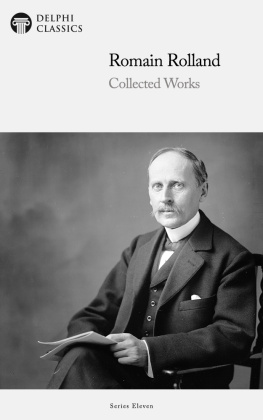Romain Gary
CRITICAL AUTHORS & ISSUES
Josu Harari, Series Editor
A complete list of books in the series
is available from the publisher.
Romain Gary
The Man Who Sold His Shadow
Ralph Schoolcraft

Copyright 2002 University of Pennsylvania Press
All rights reserved
Printed in the United States of America on acid-free paper
10 9 8 7 6 5 4 3 2 1
Published by
University of Pennsylvania Press
Philadelphia, Pennsylvania 19104-4011
Library of Congress Cataloging-in-Publication Data
Schoolcraft, Ralph W.
Romain Gary : the man who sold his shadow / Ralph Schoolcraft.
p. cm. (Critical authors & issues)
Includes bibliographical references and index.
ISBN 0-8122-3646-7 (cloth : alk. paper)
1. Gary, Romain. 2. Authors, French20th centuryBiography. 3. Gary, RomainAnonyms and pseudonyms.
I. Title. II. Series.
PQ2613.A58 Z875 2001
843'.912dc21
Contents
Preface
Far as gold on earth transcends in estimation merit and virtue, so much higher than gold itself is the shadow valued; and as I had earlier sacrificed wealth to conscience, I had now thrown away the shadow for mere gold. What in the world could and would become of me?
Von Chamisso, The Wonderful History 12
Adalbert von Chamissos Peter Schlemihl (1813) tells a Faustian tale about what happens to a man who sells his shadow. Of humble means and origins, Schlemihl goes looking for work in a foreign country. A letter of introduction gains him entry into an elegant garden party, but the behavior of the guests shows that an outsider is worth little or nothing in their eyes. Late in the afternoon, however, a mysterious gentleman with magical gifts proposes an unusual deal: the gentleman will hand over an inexhaustible bag of riches in exchange for Schlemihls shadow. Thinking his shadow an entity of little value or utility, Schlemihl lets himself be seduced by the promise of a life of money and ease. With boundless wealth at his disposal, he realizes that he could become anyone he desires. He willingly yields his shadow to the elderly man and embarks on what he imagines to be a limitless adventure of new existences.
Well-intentioned and even a bit unsettled by his sudden privilege, Schlemihl showers gifts upon a neighboring hamlet. The villagers celebrate him as a king, and soon he is engaged to a beautiful young woman of good heart and character. This idyll is shattered, however, when Schlemihl comes across a cluster of peasants in broad daylight. They react with horror and disgust upon noticing that he no longer has a shadow. Wounded by their scorn and insults, shunned by all, Schlemihl is forced to abandon his plans for marriage and takes up the solitary ways of a social outcast.
Why such humiliation over a missing shadow? What is a shadow in the final analysis? At first glance, it appears to be nothing but a vague and obscure surface, a projection that takes our form but not our consistency. But while it is not our double, it can be observed by those who meet us in public. It is that face of ourselves that we project in the light of public scrutiny, an intangible but perceptible image derived from our presence. Schlemihl comes to understand that he has been dispossessed of an essential part of himself, an aspect of his identity that is not so important in his intimate relationships but crucial to his position in society.
Through naivet more than greed, through carelessness more than excessive self-interest, Schlemihl finds himself treated as a pariah. Now that he regrets his trade, however, he discovers that it is too late to negate the exchange. Worse, the only way for Schlemihl to get his shadow back is to enter into an even more diabolical pact: he must sign over his soul.
Seeing the devious stranger now for who he really is, Schlemihl is desperate and distraught but nonetheless much the wiser for the loss of his shadow. He recognizes that he is incomplete without it yet would incur even greater hardship were he to give up his soul. Schlemihl thus spites the devil by refusing the new offer. The two of them become locked in a strange battle of will and wits, Schlemihl desiring to take back his shadow and the devil lusting after Schlemihls soul. In a fight with this powerful adversary, Schlemihl succeeds in stealing away a magic hat that gives him the gift of invisibility. Schlemihl is still shadowless, but at least now he can move about unbeknownst to others. His enjoyment of this brief triumph is short-lived, however, for outsmarting the devil has its price. Realizing the hopelessness of his situation but at peace with his new understanding of himself, Schlemihl ultimately chooses to abandon the society of humankind, leaving to others the responsibility of telling his story.
Von Chamissos parable of a shadow imprudently surrendered and a soul artfully defended has its counterpart in the life of one of Frances most popular novelists, Romain Gary. In the book that follows, we will examine the case of this impoverished migr author who unwittingly sells his shadow for wealth and a new identity before he too discovers the difficulty of recovering it intact. Gary endures the curse of the schlemihl: in Yiddish, a person tracked by hard luck, an eternal underdog whose innocence and stubbornness are tested by many hardships. Like Schlemihl, Gary is not able to undo this pact and can only ease his sense of alienation by devising a trick that renders him invisible as well. Taking Von Chamisso literally when the nineteenth-century author advises that in seeking solutions one should not overlook solid bodies, Gary invents a new person and shadow who circulate in his stead. In essence, as we will see, having failed to regain his old shadow, Gary creates a new one that borrows a body. Thus endowed with someone elses existence, he embarks on an adventure unparalleled by any other in French literature.
After the revelation in 1981 of the existence of Garys elaborate pseudonymous alter egos, his return from literary exile was assured. Indeed, in the two decades since his death, twenty books on Romain Gary have appeared in French, German and Danish, spanning the gamut from popular biography to theoretical analysis. This book, the first in English dedicated to his complex literary career, provides an introduction to his work at the same time as it offers a test case of sorts for investigating the workings of public image and authorship in twentieth-century French letters.
For the several shadows we will be examining here, there is only one individual behind them. I will call him Romain Gary, since this became his legal name in 1951. My intention is not to reestablish Garys biography (though of necessity I refer to it frequently and I provide brief summaries at the beginning of each chapter). Due to a variety of factors (Garys moves from country to country, the chaos wrought by the Russian Revolution and World War II, the discretionary nature of the posts he occupied, the scarcity of living contemporaries or family members, and his personal philosophy on such matters), a full, accurate account of several periods of his life is no longer possible. Moreover, as we will see, the very notion goes counter to important facets of his literary project. Instead, I will trace out, as accurately as possible, the invention of Romain Gary and the successive reinventions of Romain Gary; that is, I will draw up Romain Garys various
Next page









